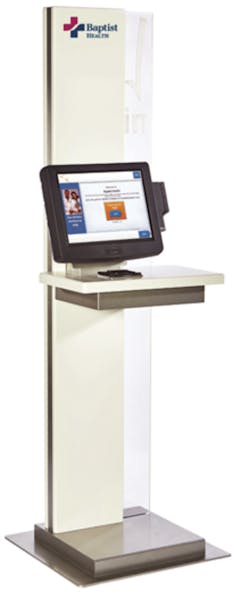After reviewing the four previous feature stories in HMT’s Living Case Study series on using self-service kiosks for patient check-in, it seemed appropriate to summarize the decision-making processes, rollout and results of installing the technology at Baptist Health. This is where it all comes together, and who better to provide that overarching perspective than Katrina Belt, Chief Financial Officer, Baptist Health, Montgomery, AL?
HMT wanted to learn more about the administrative decision-making that occurred during the lifecycle of this implementation; the impact on staff, workflow and morale; patient (user) acceptance; and if the technology truly can strengthen the information chain for both patients and caregivers. And maybe, just maybe, we could get a real answer to the big-picture question, “Can do-it-yourself technology really serve patients better?”
When you started seeing a need for a new process or solution at check-in, how did it start and how did the kiosks spread throughout your campuses?
With the acquisition of the Montgomery Cancer Center, it was really a wonderful opportunity for us, because the solution we were searching for just sort of fell into our laps. They already had self-service kiosks in their check-in area. We learned later that they were put in place because the physicians at the center realized it would be more efficient economically, and their registration staff wanted more time to form real bonds with their patients. They did all the leg work for us. It was unique in that we didn’t have to step off into making that big decision.
Was there some initial skepticism within the administration?
We were nervous about presenting it to the staff. We thought the staff would think, “Oh my goodness. I am being replaced by a computer.” We anticipated that sort of initial push back from them. When we showed them, however, that if we could use the kiosks to take the simple, sometimes tedious steps of the check-in process away from them so that they could really talk to the patients, they instantly bought into the idea. They knew that the minutiae of record keeping often gets in the way of other personal matters, whether its financial counseling or setting up follow-up visits. It did not take long for our patient registration specialists to understand that there would still be a vital role for them in their department.
At the same time, I know, as a Chief Financial Officer, that other administrators might say, “You are introducing patient-friendly technology so you can take advantage of not having to commit to all those full-time employees (FTEs).” That’s short-sighted thinking. Our administration wanted technology that was really going to help us get better information, but not necessarily aimed at replacing FTEs. Yes, you can have fewer FTEs, but you can also empower those FTEs and demonstrate to them that you believe that they are not just notetakers. Their job is important, and they are not going to be replaced. There were some delicate conversations early on, but they were very well managed during the rollout – and they were very well received by the staff.
How do you quantify the efficiencies that you have experienced after installing the self-service kiosks?
I don’t know that I have a hard number that I have saved this many dollars. A lot of our efficiencies are more anecdotal in nature than hard facts. I can say our average patient check-in time has gone down to two minutes and 18 seconds. Over the course of the year, we had 412,000 patients. So for 412,000 separate instances we only required two minutes and 18 seconds to complete some critical patient registration elements. We also greatly enhanced the time patients can spend with our registration specialists. They are now able to more consistently ask people if they are interested in a lung screening. We are able to ask more people if they have had their routine mammogram. You can now generate other lines of business or just help treat our individual patients with more specialized attention. Those are the sorts of efficiencies that hardly ever appear on a spreadsheet, because most don’t have the time to ask so many extra questions at check-in. We see them every day.
What about the functionality of the kiosks? How do they hold up to day-to-day use?
They’re very durable and easy to maintain. We were concerned from an infection-control standpoint, given that everyone using the kiosks had to touch the screen. We place hand sanitizer by each screen, and we wipe them down often. The touch-screen technology is very easy to use. Many patients say that it’s just like working on an iPad. As a CFO being concerned with replacement costs, I really need our equipment to be able to stand up to long days of continued use. I need to trust that what I am investing in will be there for my staff and patients for the long haul.
And what about the scanning capabilities? As opposed to the traditional input of information at check-in, how is information scanned into one of your kiosks?
Most of our patients read at a third-grade level, so it is critical that they be able to understand and feel comfortable with any instructions that they are given. Each kiosk shows our patients exactly where and how to place their driver’s license to be scanned and then how to place their insurance card: face up then flip it over.
The best part is the kiosk saves us time. Because those scanned images are already attached to the patient’s information, we are able to electronically feed that information into their file. So I no longer have to worry about where that information goes. Other pieces like a consent-to-treat form, which is required any time I touch a patient, especially a Medicare patient, can be electronically embedded in the patient’s record. We have the right information going to the right place automatically, and we don’t have to worry about somebody manually having to do all of that work.
What a difference a multi-capability kiosk makes
In January 2014, Baptist Health, a three-hospital faith-based system serving Central Alabama, announced the rollout of patient self-registration solutions that kiosk-software company Clearwave developed with its vendor partners Posiflex, Acuant and Image Manufacturing Group (IMG). Patients can use the kiosks at Montgomery Cancer Center, Carmichael Imaging, Montgomery Breast Center, Baptist Breast Health Center, Prattville Baptist Hospital, Prattville Imaging Center, Baptist Health Physician Group, and Baptist Medical Center South, including in the Emergency Department.
With self-service solutions, ease of use is the name of the game. Montgomery Cancer Center served as the first-adopter for the self-service technology. According to Jeri Pack, CHAM, Director, Revenue Cycle Solutions, Baptist Health, the average age of the 450 patients per day seen at the center is 62. “You would not think this type of technology would lend itself to cancer patients, especially given the high volume we treat,” says Pack, “but just the opposite is true.”
“Their average check-in time at the kiosk is just over two minutes,” says Pack. “A registrar can’t work that fast with a high level of accuracy, but our kiosks can.”
The self-check-in kiosks have also helped the staff to reduce their involvement with frequent and time-consuming activities, such as inputting basic information and dealing with duplicate records.
“Our kiosks do not replace staff,” says Pack. “They enhance what they can do, and they enable us to provide new services such as true financial counseling on the front end.
”And rule No. 1 is that patients are never left hanging. “There is not a single location where we have a kiosk that we don’t have a real, live human being that can help the patient,” says Katrina Belt, Baptist Health CFO.
Key features of the Baptist Health kiosk systems were developed by a unique industry partnership and crafted with the healthcare provider and the patient in mind:
• Clearwave, a leading provider of self-service kiosk registration and eligibility verification solutions: Automates eligibility verification and greatly reduces the time patients spend checking in and sitting in the waiting room.
• Posiflex, a maker of point-of-service (POS) and industrial touch terminals and hardware: The nearly indestructible Posiflex terminals are fanless, come in various configurations and sizes, and are capable of having privacy filters added.
• Acuant (formerly Card Scanning Solutions), a leading image-processing and OCR software company: Instead of requiring someone at the kiosk to type out their first name, last name and date of birth, the person can just scan all of that information using Acuant’s OCR technology, the same kind of technology used for scanning passports.
• IMG, a design and manufacturing company: provides a high level of customization and functionality in a branded, aesthetically pleasing and easily functional unit; clients include United Airlines and Delta.




